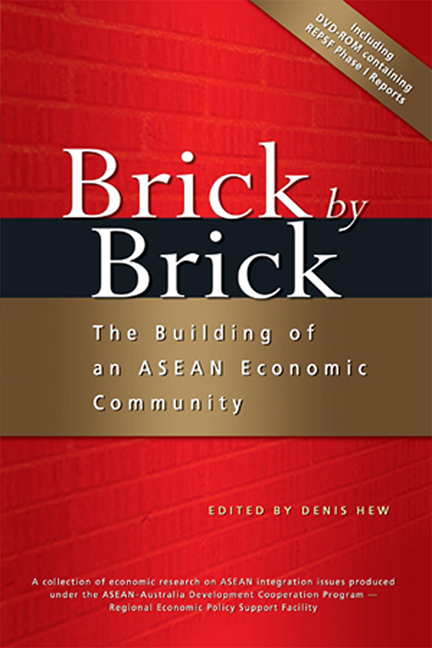Book contents
- Frontmatter
- Contents
- Foreword by Ong Keng Yong
- Foreword by Bruce Davis
- Acknowledgements by Academic Editor
- Acknowledgements by Technical Director REPSF
- The Contributors
- The Regional Economic Policy Support Facility
- 1 Introduction: Brick by Brick — The Building of an ASEAN Economic Community
- 2 What is a Single Market? An Application to the Case of ASEAN
- 3 The Challenge of Economic Integration for Transitional Economies of Southeast Asia
- 4 A Review of Regional Tariffs and Trade in the ASEAN Priority Goods Sectors
- 5 Non-tariff Barriers to Trade in the ASEAN Priority Goods Sectors
- 6 An Assessment of ASEAN's Priority Sectors for Fast-track Integration
- 7 ASEAN Tax Regimes: Impediment or Pathway to Greater Integration
- 8 An Overview of the Foreign Direct Investment Jurisprudence
- 9 ASEAN's FTA Negotiations with Dialogue Partners:Identifying Strengths and Weaknesses in Business Opportunities
- 10 Conclusion: Towards an ASEAN Economic Community by 2015
- Index
- Contents of Accompanying CD-ROM: AADCP-REPSF Phase I Research Program
9 - ASEAN's FTA Negotiations with Dialogue Partners:Identifying Strengths and Weaknesses in Business Opportunities
Published online by Cambridge University Press: 21 October 2015
- Frontmatter
- Contents
- Foreword by Ong Keng Yong
- Foreword by Bruce Davis
- Acknowledgements by Academic Editor
- Acknowledgements by Technical Director REPSF
- The Contributors
- The Regional Economic Policy Support Facility
- 1 Introduction: Brick by Brick — The Building of an ASEAN Economic Community
- 2 What is a Single Market? An Application to the Case of ASEAN
- 3 The Challenge of Economic Integration for Transitional Economies of Southeast Asia
- 4 A Review of Regional Tariffs and Trade in the ASEAN Priority Goods Sectors
- 5 Non-tariff Barriers to Trade in the ASEAN Priority Goods Sectors
- 6 An Assessment of ASEAN's Priority Sectors for Fast-track Integration
- 7 ASEAN Tax Regimes: Impediment or Pathway to Greater Integration
- 8 An Overview of the Foreign Direct Investment Jurisprudence
- 9 ASEAN's FTA Negotiations with Dialogue Partners:Identifying Strengths and Weaknesses in Business Opportunities
- 10 Conclusion: Towards an ASEAN Economic Community by 2015
- Index
- Contents of Accompanying CD-ROM: AADCP-REPSF Phase I Research Program
Summary
Introduction
The past decade has seen a rapid proliferation of regionalism among the Asian economies, which was initiated with the formation of the ASEAN Free Trade Area (AFTA) in 1992 and was essentially a free trade agreement (FTA) in goods. Thereafter, in the aftermath of the 1997–98 financial crisis and the inability of the WTO to further the multilateral trade liberalization agenda, highly trade-dependent countries in ASEAN, viz., Singapore, embarked on a new wave of regionalism as a means of enhancing the free trade agenda. More recently, other ASEAN countries such as Thailand (and later Malaysia), as well as other Asian economies, viz., Korea, Japan, China and India, have been actively pursuing this strategy to enhance economic and strategic cooperation among “like-minded” trading partners. It is in this context that ASEAN's FTA negotiations with its five major dialogue partners (DPs) — Australia and New Zealand (CER), China, India, Japan, and Republic of Korea (ROK) — assumes importance.
Since FTAs in the current context implies liberalization of not only goods, but also services and investment, it is imperative that in order to complete successful negotiations of ASEAN's proposed FTAs with its five major DPs, ASEAN will need to enter into investment negotiations with these countries. However, these countries are significantly different in terms of their economic structures and extent of economic linkages vis-à-vis ASEAN. Thus, a successful investment negotiation that can drive a twoway investment flows would require an understanding of the underlying potentials and risks of these five FTA partners with ASEAN. In this regard, the main objective of this chapter is to study the strengths and weaknesses of the five DPs vis-à-vis ASEAN, and hence carve out the possible areas of competition/complementarities of the same in the global market.
ASEAN as an Investment Destination: Strengths and Weaknesses
Internal Strengths
ASEAN is a growing market of 567 million people with a combined gross domestic product (GDP) of US$1.07 trillion. Economic growth in the region is primarily driven by investment in productive sectors, reflecting international investors' confidence in ASEAN's economic prospects. The countries strengths range from natural resource-based production to highly capital-intensive industries (electronics, textiles, automotive sector). Collectively, the region is a highly competitive production base, stemming from good infrastructure and productive skilled labour. Investors also benefit from ASEAN's geographic location between India (South Asia) and China and Japan (East Asia).
- Type
- Chapter
- Information
- Brick by BrickThe Building of an ASEAN Economic Community, pp. 175 - 208Publisher: ISEAS–Yusof Ishak InstitutePrint publication year: 2007

